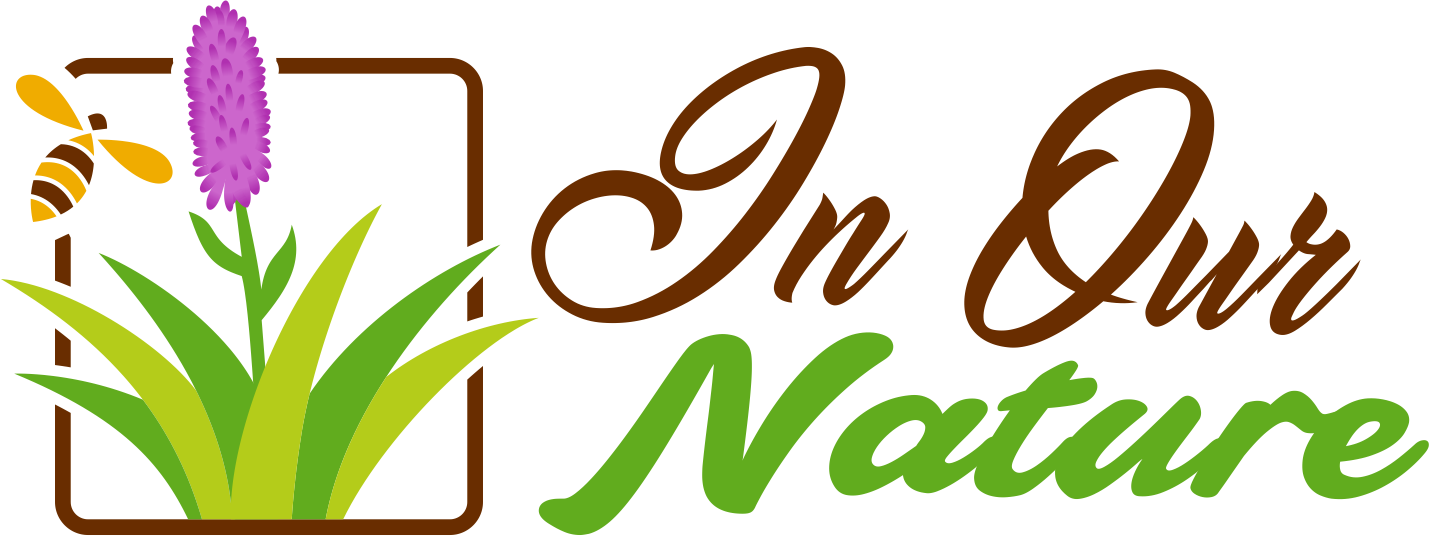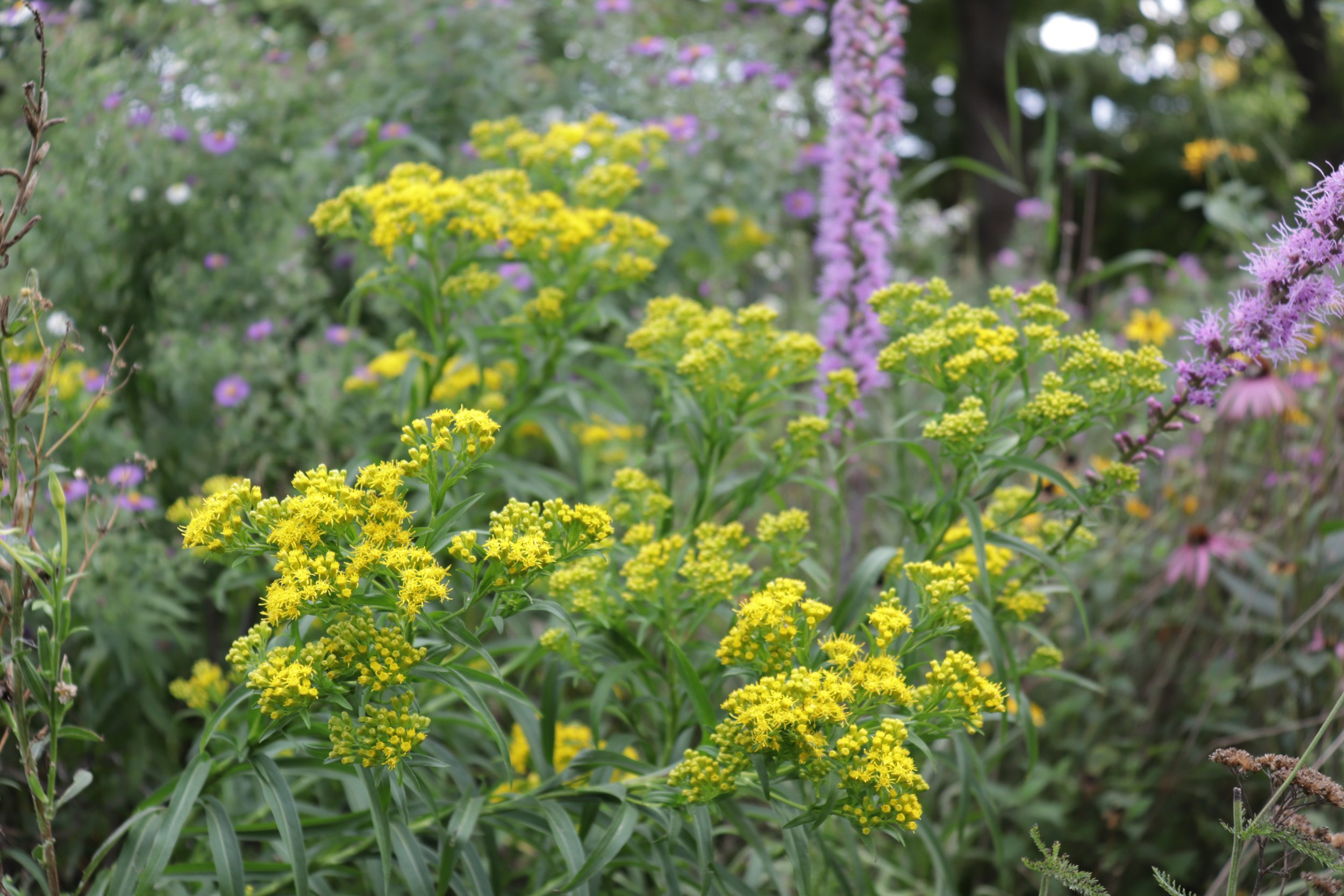Native Goldenrods for Ontario Gardens
By: Shaun Booth | Updated Nov 5th, 2020
Goldenrods are iconic fall blooming wildflowers in Ontario but they, admittedly, have an image problem. They are commonly blamed for seasonal allergies/hay fever and are often considered thugs in the garden. Both perceptions need to be reconsidered so that the good qualities of goldenrod can be understood.
First of all, does goldenrod cause hay fever? Not at all! Goldenrod is not the cause of hay fever for one simple reason: its pollen is too heavy to be blown around in the wind. Heavy pollen is transported by pollinators and does not find its way to our noses. The real culprit is most likely Ragweed which blooms at the same time as Goldenrod but it’s pollen is easily blown around by the wind (we acknowledge that some people are allergic to Goldenrod but this is the exception).
Second, out of the 30 or so Goldenrods species in Ontario, there are several well-behaved choices that make wonderful additions to pollinator gardens and do a great job at hosting the caterpillars of butterflies and moths that we love (and need) to have around. The goldenrods in this list are relatively easy to source from native plants nurseries in Ontario, including ours:
The benefits of growing Goldenrod in your garden:
Diversity
The showy yellow flowers of Goldenrod will light up any space, even in the shadiest of corners. In addition, Goldenrods are very diverse plants, with a Goldenrod species for almost any possible growing condition in your yard. If you have dry shade, plant Zigzag Goldenrod. If you have clay soil, plant Stiff Goldenrod. If you have wet soil, plant Bog Goldenrod. You get the idea!
Important nectar and pollen sources
Goldenrods are some of the most important fall-blooming native plants for pollinators. Fall blooming flowers are especially important to ensure that pollinators such as Bumblebee Queens have the food source they need before going into hibernation. Late blooms are also important for migrating species such as Monarch butterflies who need to stock up on energy for their trip to Mexico.
Host Plants
Goldenrod is a host plant for the caterpillars of over 115 different butterfly and moth species! By feeding the caterpillars, we are more likely to see the adults butterflies and moths in our gardens. In addition, by feeding caterpillars, energy can be moved up the food chain to birds and other wildlife. In fact, 96% of bird species feed their young insects, not seeds or berries. By providing high quality host plants such as Goldenrod, you can help ensure that birds have enough food to raise their young.
Specialist Pollinators
The copious amounts of pollen in the flowers attract a wide variety of pollinators, including specialist bee species.
Juglone Tolerant
Goldenrods are juglone tolerant meaning you can grow them near Walnut trees!
Zigzag Goldenrod (Solidago flexicaulis)
1. Zigzag Goldenrod (Solidago flexicaulis)
Sun: Part shade - shade
Height: 3ft
Blooms: Yellow, August, September
Soil: Sand, loam, clay
Moisture: Medium to dry
A pollinator magnet for shady gardens! Reaching about 3ft tall, the stems have an attractive Zigzag form with bright yellow flowers concentrated along its upper stem. These flowers are some of the most fragrant out of all of the native Goldenrods in Ontario.
Zigzag Goldenrod is usually found in forests and forest edges so it will do well in your garden if you give it part to dappled shade with average to dry soil (that means it grows in dry shade!). It will tolerate clay soils too! You can expect it to spread slowly by rhizomes and a little bit faster by seed.
Pair it with large-leaved Aster or Calico Aster for a pollinator buffet. Bumblebees are common visitors to Zigzag Goldenrod.
Bluestem Goldenrod (Solidago caesia)
2. Bluestem Goldenrod (Solidago caesia)
Sun: Part shade - shade
Height: 3ft
Blooms: Yellow, August, September
Soil: Sand, loam, clay
Moisture: Average, dry
Bluestem Goldenrod features graceful, arching stems and bright yellow flowers that brighten up the shade. The purple/blue stems and yellow flowers really come together for a striking display especially when planted in big clumps.
Bluestem Goldenrod grows well in shade to part shade with rich moist soil and even grows in rocky soils. This is a very well-behaved Goldenrod, forming small colonies and will self-seed, but not aggressively.
Bees will love you for providing them with these late season blooms! A winning combination is Bluestem Goldenrod, Heartleaf Aster and Bottlebrush Grass.
Stiff Goldenrod (Solidago rigida)
3. Stiff Goldenrod (Solidago rigida)
Sun: Full sun
Height: 5ft
Blooms: Yellow, August, September
Soil: Sand, loam, clay
Moisture: Dry, average
A beautiful, upright Goldenrod with a clumping form and large oval leaves. The rigid stems are topped with a large, showy cluster of yellow flowers in late summer.
Give it average moisture in well drained soil with full sun. Note that it may flop in rich soils or if it doesn’t have enough plants nearby to provide competition. Although its clump-forming, it may self-seed in bare soil but planting your garden densely will prevent this.
The flat topped flower clusters make a great landing pad for butterflies, especially Monarch Butterflies. Small birds love eating the seeds. Stiff Goldenrod is rare in the wild in Ontario.
Upland White Goldenrod, (Solidago ptarmicoides)
4. Upland White Goldenrod (Solidago ptarmicoides)
Sun: Full sun
Height: 2ft
Blooms: White, August, September
Soil: Sand, loam, clay
Moisture: Dry, average
One of two white goldenrods in Ontario! Upland White Goldenrod features an elegant, mounding form and flat-topped clusters of daisy-like flowers.
Upland White Goldenrod prefers full sun and dry sandy soils but it will grow well in most gardens with well-drained soil and full sun. It’s an especially good native plant for rock gardens as it tolerates poor and shallow soils. Best grown with plants of a similar height.
It spreads by seeds but is not aggressive so you can grow it in a small space without having it take over.
Grass-leaved Goldenrod (Euthamia graminifolia)
5. Grass-leaved Goldenrod (Euthamia graminifolia)
Sun: Full sun, part sun
Height: 4ft
Blooms: Yellow, August, September
Soil: Sand, loam, clay
Moisture: Wet, average, dry
Ok, technically, Grass-leaved Goldenrod is not a Goldenrod but it looks and acts very similar. In Late summer it shows off with flat topped clusters of yellow flowers. The narrow, grass-like leaves make this one easy to identify from other goldenrods.
Grass-leaved Goldenrod grows best in full sun to light shade with rich, moist soil (although it’s drought tolerant when established) where it can grow up to 4ft tall. It spreads at a moderate rate by rhizomes and seed to form colonies, but not to the point where it’s aggressive.
This is a bumblebee and native bee magnet! It is also attracts many predatory insects that prey upon pest species in your garden, thus reducing the need for pesticides.
Pair it with New England Aster, Wild Bergamot or False Sunflower.
Showy Goldenrod (Solidago speciosa)
Sun: Full sun
Height: 3ft
Blooms: Yellow, August, September
Soil: Sand, loam, clay
Moisture: Dry, average
Hence it’s common name, it is often considered the showiest of Goldenrods in Ontario with its feathery plumes of yellow flowers and it’s erect growth habit. It grows well in dry to medium soils in full sun and reaches 3-ft in height. It will tolerate poor soil and clay.
Showy Goldenrod spreads by rhizomes and seeds but spreads faster in moist soils. Showy Goldenrod is rare in the wild in Ontario.
It blooms later than most other Goldenrods making it perfect for extending bloom time in pollinator gardens. Expect to see numerous late-season butterflies and native bees visiting it.
Pair it with Big Bluestem, Dense Blazing Star or Smooth Blue Aster.
7. Gray Goldenrod (Solidago nemoralis)
Sun: Full sun
Height: 2ft
Blooms: Yellow, August, September
Soil: Sand, loam, clay
Moisture: Dry, average
Gray Goldenrod is a very underutilized species in Ontario native plant gardens. It’s a low growing Goldenrod with an attractive arching form and a dense head of showy yellow flowers. This is one of the lowest growing native Goldenrods in Ontario, usually staying under 2ft in height.
It spreads slowly by rhizomes to form colonies but may self-seed around the garden. Make sure to plant it in large clumps for the best effect.
Pair it with Upland White Goldenrod, Heath Aster or short grass species such as Little Bluestem or Sideoats Grama.
8. Riddell's goldenrod (Solidago riddellii)
Sun: Full sun
Height: 3ft
Blooms: Yellow, September
Soil: Sand, loam, gravelly
Moisture: Wet to moist
The flat-topped flower clusters of Riddell’s Goldenrod rise above its grass-like leaves to add a vibrant splash of yellow to the late summer garden. This goldenrod is most often found in marshes and other wet areas, making it a great choice for rain gardens, swales or other wet areas although it does well in my garden with average moisture.
It is not an aggressive spreader but may self-seed around the garden.
Pair it with moisture-loving species such as Spotted Joe-pye, Swamp Aster or Boneset.
9. Bog Goldenrod (Solidago uliginosa)
Sun: Full sun
Height: 4ft
Blooms: Yellow, late summer/fall
Soil: Most well-drained soil. Prefers boggy soils.
Moisture: Wet to medium
One of the earliest goldenrods to bloom! Bog Goldenrod send up stunning spires of showy yellow blooms that will be loaded with bumblebees all season.
The flowers mature into fluffy seed heads in the fall while the foliage turns wonderful shades of red.
It typically maintains a clumping habit but will freely self-seed. Great for rain gardens and bog gardens due to its preference for wet, mucky soils but will also tolerate average moisture once established.
Very under-used in native plant gardens but it definitely deserves a spot in your yard.
10. Silverrod (Solidago bicolor)
Sun: Full sun to part shade
Height: 4ft
Blooms: White and yellow, Late summer- fall
Soil: Sand, loam, clay
Moisture: Average to dry
One of two white goldenrods in Ontario, Silverrod is equally as stunning as its yellow counterparts. In late summer, it send up spires of many elegant white flowers with yellow centers.
Easy to grow and adaptable to a variety of light and soil conditions. It maintains a clumping form although it does like to self-seed in bare spots.
Really great for providing contrast to the sea of yellow flowers that are common in garden in the fall months.
The white flowers are especially attractive to beneficial insects.












